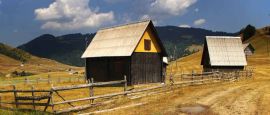Montenegro Food and Drink
Montenegro's cuisine reflects its diverse landscapes, blending Mediterranean, Balkan, and Eastern European influences. Along the coast, expect fresh seafood dishes like black risotto, grilled octopus, and brodet (fish stew), often accompanied by local olive oil and fresh herbs. Inland, heartier fare takes the spotlight, with dishes like kačamak (a creamy potato and cheese dish), čevapi (grilled minced meat sausages), and raštan (braised collard greens with smoked meat).
Montenegrins take pride in their cured meats and cheeses, particularly Njeguški pršut, a dry-cured ham from the mountainous village of Njeguši, and Pljevaljski sir, a rich local cheese. For dessert, try priganice, bite-sized fried dough served with honey or cheese, or krempita, a creamy custard pastry.
When it comes to drinks, Montenegro produces excellent local wines, particularly Vranac (red) and Krstač (white), as well as the potent fruit brandy rakija. On a cooler day, a warm cup of Mountain Tea (Sideritis) is both soothing and refreshing.
Dining options range from casual konobas, rustic taverns serving traditional fare, to more formal restorans, where you can enjoy a fusion of local and international cuisine.
Njeguški pršut: Dry-cured ham from the mountain village of Njeguši, often served with local cheese and olives.
Kačamak: A traditional dish made with potatoes, cornmeal, and cheese, similar to polenta, usually served with sour cream.
Raštan: A hearty dish of braised collard greens with smoked meat; popular in winter.
Pljeskavica: A spiced, homemade beef or mixed meat patty, often served with fresh bread and ajvar (pepper relish).
Ćevapi: Grilled minced meat sausages, typically served with flatbread, onions, and a tangy relish.
Jagnjetina ispod sača: Lamb slow-cooked under a metal bell (sač) with potatoes and vegetables, resulting in tender, flavourful meat.
Crni rižot: Black risotto made with cuttlefish ink, a coastal delicacy.
Riblja čorba: A rustic fish soup often made with freshwater fish, tomatoes, and aromatic herbs.
Priganice: Bite-sized fried dough often served with honey, cheese, or jam.
Krempita: A dessert featuring layers of creamy custard between light pastry.
Vranac: A robust red wine made from the native Vranac grape, known for its rich and fruity flavour.
Krstač: A crisp white wine with a light and aromatic profile, perfect for pairing with seafood.
Rakija: A potent fruit brandy, often made from grapes or plums and sometimes flavoured with herbs or fruit.
Nikšićko pivo: The most popular Montenegrin beer, a refreshing lager brewed in Nikšić.
Mountain Tea (Sideritis): A traditional herbal tea with soothing and aromatic qualities, often enjoyed warm.
Tipping in Montenegro is not obligatory but is certainly appreciated. The standard practice is to tip around 10% of the bill if the service is good. In more casual settings, such as cafés or for smaller bills, rounding up or leaving a few euros is considered polite.
If dining at a more formal restoran, adding a tip of 10% is customary, especially if the service exceeded expectations.
Do you have any Feedback about this page?
© 2025 Columbus Travel Media Ltd. All rights reserved. No part of this site may be reproduced without our written permission, click here for information on Columbus Content Solutions.




 You know where
You know where